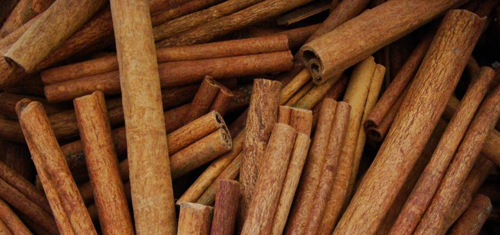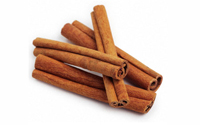Cassia
Cassia
Pronounced: Cass-ee-ah

Cassia is a spice that is produced from the inner bark of the Cinnamomum verum tree. It is also known as true Cinnamon, Chinese Cinnamon, Chinese cassia or Cinnamomum zeylanicum. It tends to be sold under the name Cinnamon when in the form of a spice, as powder or sticks of bark. However when it is sold as an essential oil it often has the name Cinnamomum Cassia.
What Is Cassia?
 Cassia is an aromatic bark, similar to cinnamon, but differing in strength and quality. Its bark is darker, thicker and coarser, and the corky outer bark is often left on. The outer surface is rough and grayish brown, the inside bark is smoother and reddish-brown. It is less costly than cinnamon and is often sold ground as cinnamon. When buying as sticks, cinnamon rolls into a single quill while cassia is rolled from both sides toward the centre so that they end up resembling scrolls.
Cassia is an aromatic bark, similar to cinnamon, but differing in strength and quality. Its bark is darker, thicker and coarser, and the corky outer bark is often left on. The outer surface is rough and grayish brown, the inside bark is smoother and reddish-brown. It is less costly than cinnamon and is often sold ground as cinnamon. When buying as sticks, cinnamon rolls into a single quill while cassia is rolled from both sides toward the centre so that they end up resembling scrolls.
Plant and Cultivation
An evergreen tree growing to 7 m with a white aromatic bark and angular branches. The leaves are oblong-lancelate about 18 cm (7 in) long. Small yellow flowers hang from long stocks, and bloom in early summer. It grows in hot, wet, tropical climates both wild and commercially. The stems are cut down when the bark is mature. The bark is removed in short lengths and dried, with some varieties rolling into quills.
Description
Cassia, is from Burma and South China, coming in quills or rolled. The cassia bark differs from the true cinnamon (Ceylon cinnamon, Cinnamomum verum) bark, in its aroma, pungency and texture. The cassia bark has a more intense aroma with higher essential oil content, not so delicately flavoured as true cinnamon and is coarser and thicker. Cassia powder is reddish-brown while true cinnamon powder is tan in colour. Cassia bark may yield 1 to 4.5 percent essential oil, while cinnamon barks, 0.5 to 2.0 percent. But the main component in both essential oils (bark) is cinnamic aldehyde.
Producing Countries of Cassia
Cassia is mainly produced in China, Indonesia and Vietnam. It is native to Burma and grown in China, Indo-China, the East and West Indies and Central America. It is called kwei in the earliest Chinese herbal by Shen-nung (2700 B.C.). Chinese cassia is produced in both China and Vietnam. Until the 1960s, Vietnam was the world’s most important producer of Saigon cinnamon, which has a higher oil content, and consequently has a stronger flavor. Because of the disruption caused by the Vietnam War, however, production of Indonesian cassia in the highlands of the Indonesia island ofSumatra was increased to meet demand. Indonesian cassia has the lowest oil content of the three types of cassia, so commands the lowest price. Chinese cassia has a sweeter flavor than Indonesian cassia, similar to Saigon cinnamon, but with lower oil content.
Consuming Countries of Cassia
In India and the US, the bark of the cassia cinnamon tree is most widely used. Both the bark and the powdered variety of cassia cinnamon are used as flavouring agents. The buds of this plant are also used, albeit rarely, mainly in India.
Grades of Cassia
Cassia Tube
Cassia Split
Broken Cassia
| SPECIFICATION | SUGGESTED LIMITS |
| ASTA CLEANLINESS SPECIFICATION | |
| Whole Dead Insects, by Count | 2 |
| Mammalian excreta, by mg / lb | 1 |
| Other excreta, by mg / lb | 1.0 |
| Mold.% by Weight | 5.00 |
| Insect Defiled / Infested, % by Weight | 2.50 |
| Extraneous,% by Weight | 0.50 |
| FDA DAL'S (6 SUBSAMPLES) | |
| Insect Infested Pieces by Weight | Ave. of 5% |
| OR | |
| Moldy Pieces by Weight | Ave. of 5% |
| OR | |
| Mammalian excreta identified as to source when possible | 1mg/lb |
| Volitle Oil" | Varies by Quality typical 1.5% 3.0% |
| Moisture" | 14.0% max |
| Ash" | 5.0% max |
| Acid Insoluble ash" | 1.0% max |
| Average bulk Index (mg /100 g ) | N/A |
